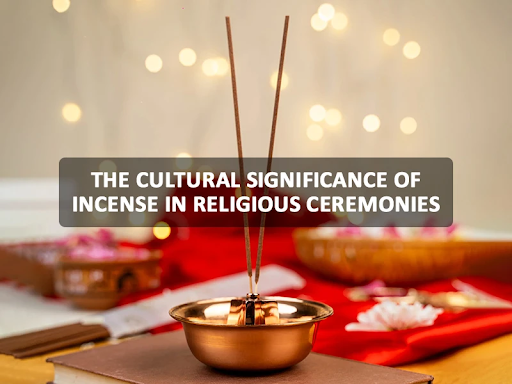
The Cultural Significance of Incense in Religious Ceremonies
Share
Incense is a material realization of the immaterial, transforming the invisible into the visible.
The aromatic wisps of smoke curled upwards, carrying our thoughts and prayers heavenward. Incense has played a profound role in religious ceremonies across cultures for centuries. Its subtle fragrance has accompanied many vital rituals and helped devotees feel spiritually uplifted. But what is the cultural significance behind this practice of burning incense?
While growing up, many of us vividly remember attending weekly prayers at the local temple with our loved ones. For example, as the priests meticulously prepared in the inner sanctum, our noses would be tantalized by the heady scents wafting through the hallways. Those fragrances represented Buddhist agarbatti, like sandalwood, rose, and Guggal, which worshippers believe invoked certain energies.
The Symbolism of Incense in Hinduism and Buddhism
Both Hinduism and Buddhism attach deep symbolic meanings to using incense in prayer. In Hindu tradition, incense represents the purification of one’s mind and the burning of karma. Wafting fragrant smoke is thought to carry prayers to the gods and mask any unpleasant odors in the sacred space. In Buddhism, incense burning also plays a crucial role in rituals and meditation, with scents like aloeswood said to signify the enlightenment of Buddha. Even today at home, you will see parents lighting incense sticks before beginning their daily puja or chanting sutras and mantras.
As prescribed in Buddhist scriptures, the smoke is taken as both an offering to the Buddhas and a means of focusing one’s mind.
We hope sharing some of my experiences and memories has offered a glimpse into incense’s cultural significance in religion, especially Hinduism and Buddhism. Its subtle yet profound symbolism continues to this day in ceremonies, marking it as an enduring tradition that links us to the spiritual practices of generations past.
Did you have any experiences with incense in your religious upbringing that you’d like to share?
The Practice of Burning Incense in Religions
As we mentioned, burning incense is essential in Hindu and Buddhist ceremonies. What many people need to learn is just how widespread the practice is among other religions as well. For example, incense is commonly used in Taoist and Confucian rituals in China, often made from natural dhoop sticks like cinnamon, clove, and sandalwood. Similarly, incense burning is integral to worship in various indigenous belief systems in Asia, Africa, and the Americas.
Many Christian denominations also incorporate incense into liturgical worship; its sweet smoke is said to symbolize prayers rising to heaven. Growing up near a Catholic church, if you studied in a convent and got a chance to visit the church, you would catch wafts of frankincense and myrrh wafting outside during special masses and festivals. The tradition originates in the Biblical references to frankincense and gifts presented to the baby Jesus. Whether it’s agarbatti burned in Hindu puja or burning incense cones as Buddhist offerings, the ritual of purifying sacred spaces through fragrant smoke unites many faiths.
Different Types of Incense Used in Ceremonies
The particular incense materials used in religious rituals often carry their layer of symbolic meaning and significance tied to the theology or philosophy of that faith tradition. For example, agarwood or aloeswood known as oud in Arabic is widely regarded in Buddhism due to its association with enlightenment. Sandalwood incense evokes qualities of purity, peace and relaxation in Hinduism.
Rose and other floral attars, too, feature as incense offerings, their floral scents connecting to ideas of love, beauty, and femininity. Even specific blends may have specialized purposes, such as jasmine incense for prosperity rites or cinnamon sticks for ancestor veneration. This insight into different incense types, like natural dhoop sticks, reaffirmed for me how intricately the practice is intertwined with religious thought across the world.
The Multisensory Experience of Incense
Beyond just the olfactory aspect, incense rituals provide a multidimensional sensory experience. The mesmerizing dance of wispy smoke curls appeals to our visual senses. Buddhists often meditate while watching incense coils rise and dissolve into the air. For Hindus, carefully lighting individual sticks or cones and making symbolic offerings has a meditative rhythm appealing to sight and touch.
Even the sounds add to the atmosphere – the crackle and pop as natural ingredients in dhoop sticks ignite, followed by a sustained sizzle as the incense burns. Combined with chanting mantras or reciting prayers, this aural layer enhances the spiritual experience. Some believe certain incense frequencies, like sandalwood, even have healing properties. The complete sensory immersion helps devotees transcend daily concerns and connect more deeply with the divine on spiritual and emotional levels.
Conclusion
So, you finally made it to the very end of our blog,
What fascinates us most about incense is how seamlessly it combines the tangible and intangible across diverse religious traditions. Whether agarbatti offered to gods or used in Buddhist meditation, its ephemeral yet evocative qualities beautifully complement the ethereal dimensions of faith. Above all, incense represents the profound yet simple ways we express devotion – through using our senses to lift our hearts, minds and prayers to places beyond our ordinary comprehension. We hope sharing some perspectives has conveyed its cultural and symbolic significance for many.
